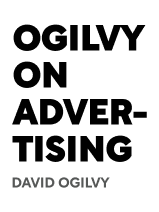

This article is an excerpt from the Shortform book guide to "Ogilvy On Advertising" by David Ogilvy. Shortform has the world's best summaries and analyses of books you should be reading.
Like this article? Sign up for a free trial here .
What is Ogilvy on Advertising? What advice does David Ogilvy give on advertising? What are his views on how to bee successful?
In Ogilvy on Advertising, ad powerhouse and “the father of advertising” David Ogilvy gives insight into how to create ads and how to make it in the advertising industry. Ogilvy outlines his core principles for ad campaigns and gives advice for starting your own agency.
Keep reading for David Ogilvy’s advice from Ogilvy on Advertising.
David Ogilvy on Advertising
David Ogilvy (1911-1999), the “father of advertising,” started one of the most successful advertising agencies in the world and worked with major clients such as Rolls-Royce, Shell, and Hathaway. In Ogilvy on Advertising, Ogilvy shares his decades’ worth of experience as a salesman, copywriter, and adman.
Ogilvy will teach you the craft of advertising—how to create legible, easy-to-understand print ads, engaging radio ads, and TV commercials that sell. He’ll also cover how to use marketing and research to increase your chances of success. Finally, he’ll give an overview of the advertising industry as it stood in 1985 (when the book was published), covering how to get a job in advertising, run an agency, find an agency, and manage public opinion. David Ogilvy’s advice on advertising is one of the defining texts on advertising.
Marketing and Product Development
The ultimate goal of advertising is to sell products, but in fact, the best way to increase sales isn’t to advertise effectively—it’s to supply good products. To create good new products, or improve the products you already have:
- Use research. The Ogilvy method says research can predict which kinds of products will do well; what smells, colors, flavors, and recipes will be most popular; what features consumers think are most important; what package designs are most attention-grabbing; and what types of products people are no longer interested in.
- Improve product quality. If your research tells you consumers prefer your competitors’ products, you can ask your R&D to improve yours. Especially for food products, improving quality improves sales.
- Balance convention and novelty. Products can fail both because they’re too similar to something that already exists or because they’re too outside-the-box, and no one knows what to do with them. Products that are different versions of something that consumers are already familiar with tend to do well, such as disposable diapers or diet soda.
- Give the product a good name. People’s names (Ford) or descriptive names (Band-Aid) are effective. Make sure names aren’t hard to pronounce, hard to remember, or similar to other names.
- Choose an appropriate price and use promotions. People judge products by their price and think more expensive products are of better quality.
- Put your resources towards your successes. It’s better to spend your time and money on the products that do well, rather than trying to save flops.
- Put a lot of effort into the launch. According to an advertising expert at the London Business School, consumers alternate buying four or five different brands of a particular product. To get a new product into someone’s repertory, you need to convince her to buy it within a year of its launch.
David Ogilvy on Advertising: The Craft of Advertising
The primary goal of advertising is to increase profit, which you can do either by attracting new customers or encouraging existing customers to buy your product more often. Effective advertising can be very effective—one copywriter found that a good ad sold almost 20 times as much as a bad one. Even if products sell well on their own, good advertising can increase profit. The Ogilvy method explains:
- For example, Listerine sold perfectly well for 40 years. But when it was advertised as a cure for bad breath, sales exploded.
There are some steps to creating good ads regardless of the medium:
1. Learn about the product. It’ll be easier to make associations and come up with potential benefits when you have a solid knowledge base.
2. Study your competitor’s ads. When you come across effective ads, study and copy the techniques used. Particularly study direct-response ads (ads that encourage consumers to contact a company directly to make a purchase) because there’s a clear relationship between advertising and sales—the only factor that affected someone’s decision to buy a product was the ad, so the variables have been tested.
3. Engage in research. Use research to find out what customers think of your company and how much money you need to put into advertising to increase sales. Additionally, use research to find out what product promise will most appeal to consumers who might be your target audience, what promotions or premiums people might be interested in, and what media will get you the most response.
Later, once you’ve released some ads into the world, continue to use research to inform your next campaign. Study whether your existing ads are confusing, how many people read or view them, and at what point people get tired of the message and a new campaign is necessary.
4. Choose a brand image. “Image” is the personality of a product, which stems from its inherent qualities as well as marketing variables such as price, packaging, and advertising style.
- For example, in Ogilvy on Advertising, Jack Daniel’s whiskey projects an image of quality because it’s expensive.
5. Come up with big, timeless ideas. Big ideas will hook consumers and make your competitors jealous. Induce ideas by doing your research and then letting your mind unconsciously connect ideas as you go for a walk, drink, or take a bath.
6. Spotlight the product and make it the star. If there’s nothing different or unique about your product compared to your competitors’ (for example, you sell table salt), make the advertising itself unique, or be extra clear and convincing.
7. Avoid working in committees. Committees tend to overcomplicate things and require compromise, and as a result, the final ad tends to say nothing of importance. Committees also slow down creation.
Now that you know the Ogilvy method, you can work on incorporating these principles into your own method.

———End of Preview———
Like what you just read? Read the rest of the world's best book summary and analysis of David Ogilvy's "Ogilvy On Advertising" at Shortform .
Here's what you'll find in our full Ogilvy On Advertising summary :
- What the "father of advertising" has learned from his decades' of experience
- How to craft easy-to-understand ads that work
- The 6 pioneers of the advertising industry






